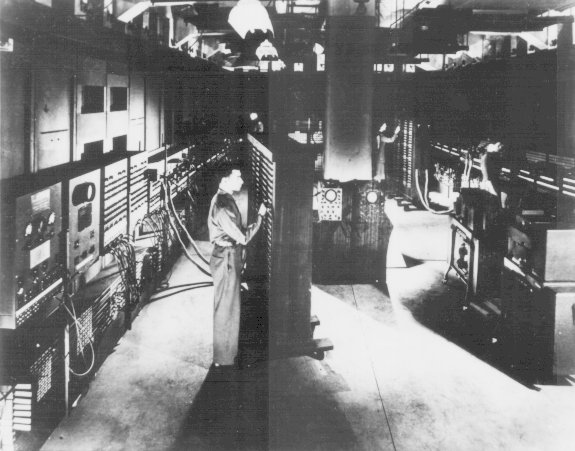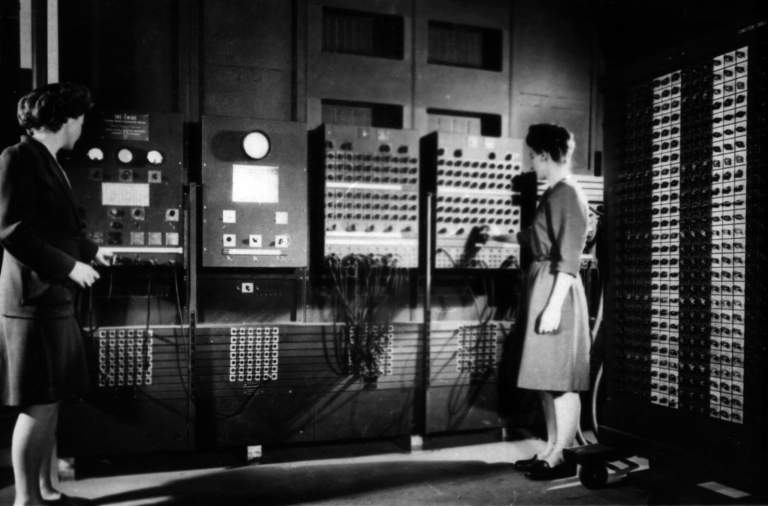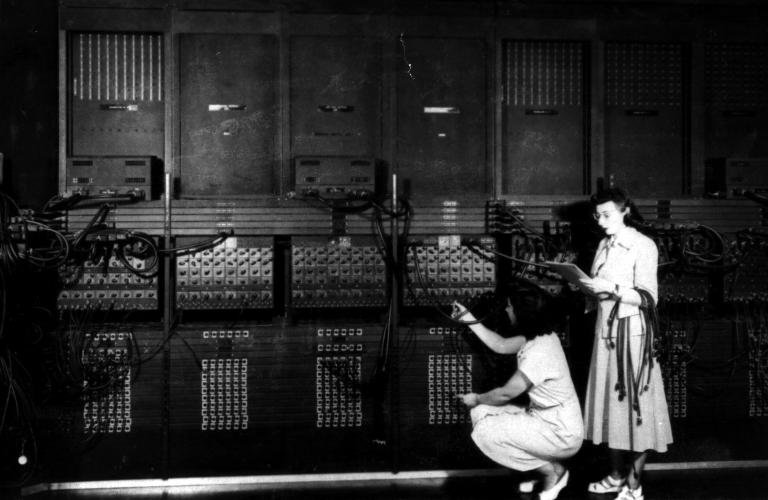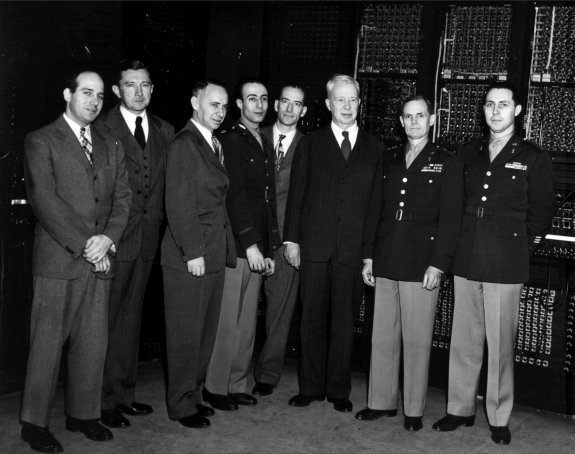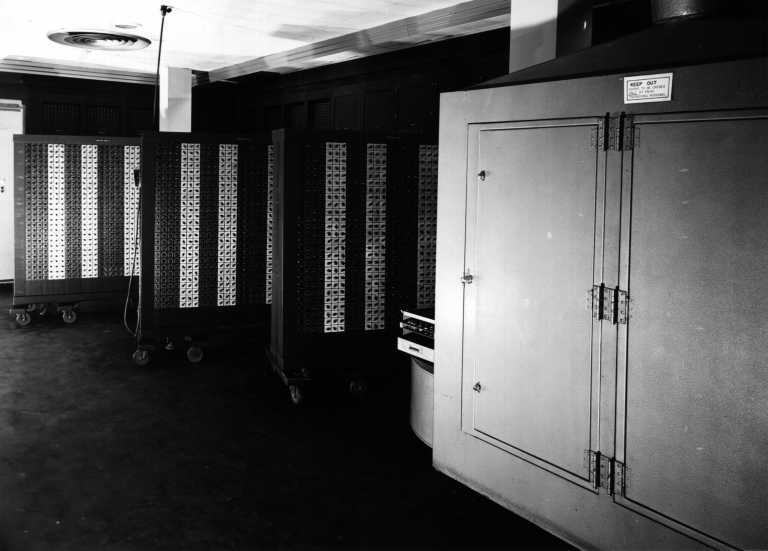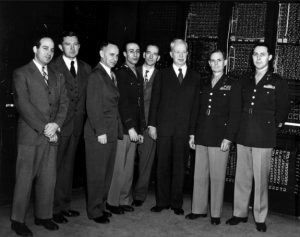ENIAC
Essay
Developed in Philadelphia during World War II, the Electronic Numerical Integrator and Computer (ENIAC) made history as the world’s first general-purpose, nonmechanical computer. Unveiled at the University of Pennsylvania’s Moore School of Electrical Engineering in 1946, the ENIAC consisted of 40 nine-foot-high cabinets containing 18,000 vacuum tubes, 10,000 capacitors, 6,000 switches, and 1,500 relays. Unlike any other computing device of its time, the ENIAC was not limited to one type of calculation and could solve many different types of problems. As the first automatic electronic digital computing machine, the ENIAC marked the dawn of the Information Age.
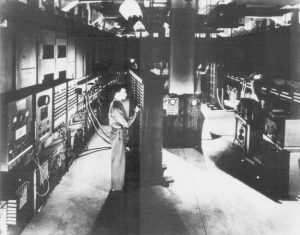
The military’s need for quick and accurate computation arose during World War I, when the United States began using mathematical computations to determine trajectories for artillery firing tables. People completed these calculations by hand and, with the male workforce depleted during wartime, women often handled the work of calculating artillery tables and trajectories. Due to the rapidly growing demand for firing tables and other ballistic data, the United States Chief of Ordnance established the Ballistics Research Laboratory at the Aberdeen Proving Ground in Maryland. As the military’s needs for firing and bombing tables increased exponentially during World War II, the Ballistics Research Laboratory required a device to keep up with the wartime demand for millions of computations.
To develop firing and bombing tables more quickly and efficiently than existing computers, the Ballistics Research Laboratory contracted with the University of Pennsylvania’s Moore School of Electrical Engineering to build an electronic digital machine. The Moore School was a logical choice for the job, as the U.S. government had previously enlisted the expertise of many of the school’s faculty and students for secret military research projects, sponsored training courses for operating complicated weapons systems, and financed a program in Engineering, Science, and Management War Training.
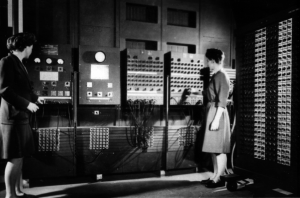
Work on the ENIAC began at the University of Pennsylvania on June 5, 1943. The computer was completed in 1945 and unveiled on February 14, 1946. Although originally estimated to cost $150,000, it ultimately cost $400,000 to complete. The ENIAC was designed and developed by University of Pennsylvania Professor John W. Mauchly (1907-80), along with graduate student John Eckert Jr. (1919-95). Six female mathematicians, Jean Jennings (1924-2011), Marlyn Wescoff (1922-2008), Ruth Lichterman (1942-1986), Betty Snyder (1917-2001), Frances Bilas (1922-2012), and Kay McNulty (1921-2006), programmed and operated the ENIAC. These women taught themselves how to program the ENIAC by using blueprints and diagrams of the ENIAC, after which they wrote the operating manual. While scientists across the globe had developed large single-purpose computing machines and calculators, the ENIAC was unique because it could be more easily reprogrammed for different tasks. Hundreds of times faster than its contemporary computers, it could complete five thousand additions per second as well as multiply 360 ten-digit numbers per second.
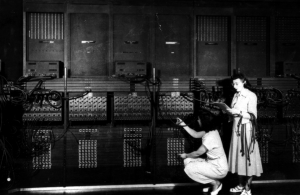
In keeping with the original contract, in 1947 the Chief of Ordnance removed the ENIAC from the University of Pennsylvania and installed it at the Ballistics Research Laboratory of the Aberdeen Proving Ground. There its tasks became more varied, including numerical weather simulations and calculations required for building the hydrogen bomb, until it was decommissioned in 1955. Honoring the machine’s place in history, pieces from the ENIAC were subsequently exhibited around the country, including at the Smithsonian Institution and the University of Pennsylvania’s School of Engineering and Applied Science.
After they finished working on ENIAC, Mauchly and Eckert resigned from the University of Pennsylvania due to a contentious dispute regarding patents, as well as other intellectual property concerns. On December 22, 1947, they founded the Eckert-Mauchly Computer Corporation (EMCC). Headquartered in Philadelphia, the company continued to invent new computer technologies, including the second iteration of the Electronic Discrete Variable Automatic Computer (EDVAC II), the Binary Automatic Computer (BINAC), and the beginning stages of development for the Universal Automatic Computer (UNIVAC). Three years after its founding, EMCC was purchased by and incorporated into Remington Rand, a Philadelphia-based machine manufacturer. The large bureaucracy of Remington Rand may have stunted Mauchly and Eckert’s abilities to innovate while other companies such as International Business Machines (IBM) charged ahead in developing computer technology. Nonetheless, Mauchly and Eckert’s invention of the ENIAC distinguished Philadelphia as the birthplace of the modern computer and laid the groundwork for future scientists to innovate and develop the future of computing across the country and around the world.
Grace Schultz earned an M.A. in History with a concentration in Public History from Temple University and is an Archives Technician at the National Archives at Philadelphia. (Author information current at time of publication.)
Copyright 2017, Rutgers University
Gallery
Links
- ENIAC Historical Marker (ExplorePAHistory.com)
- How Women Changed the World of Computing (Fortune Magazine)
- 70 years ago, six Philly women became the world's first digital computer programmers (PhillyVoice.com)
- ENIAC Programmers Project
- A Short History of the Second American Revolution (University of Pennsylvania)
